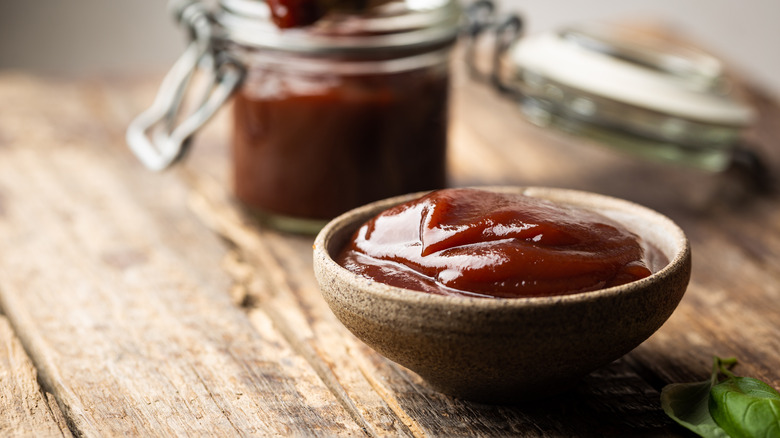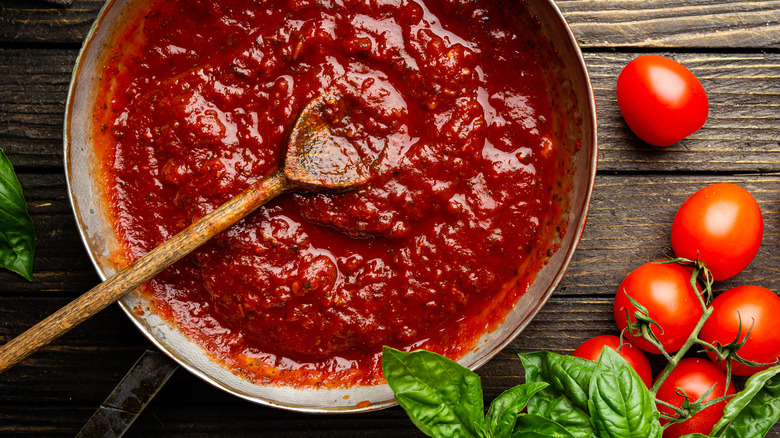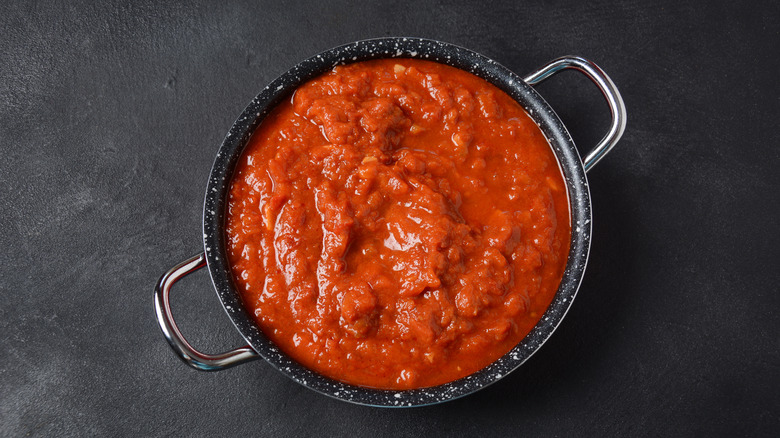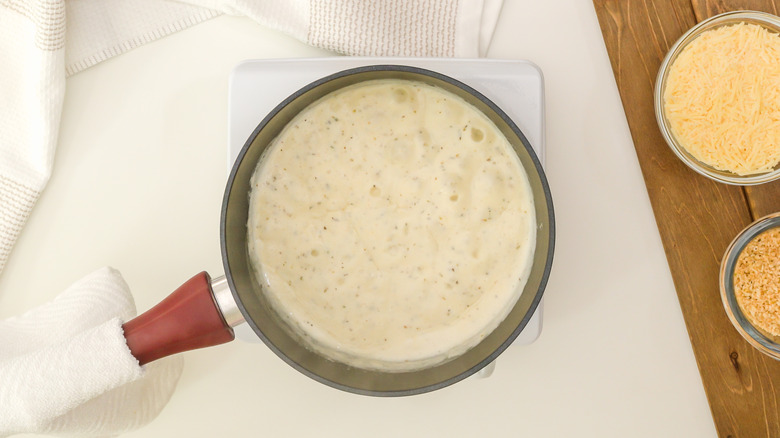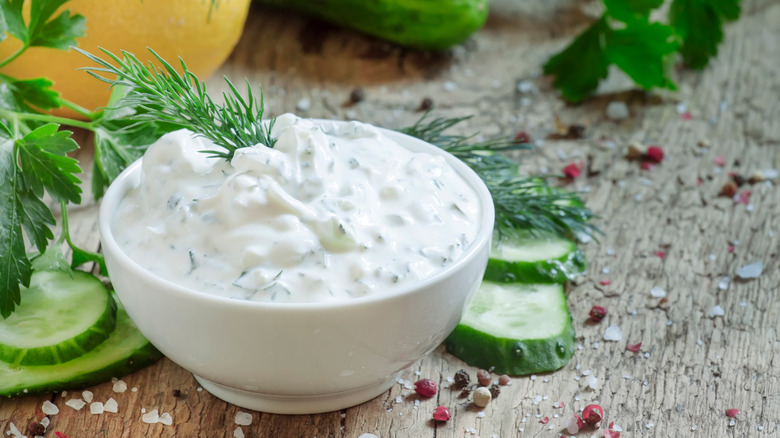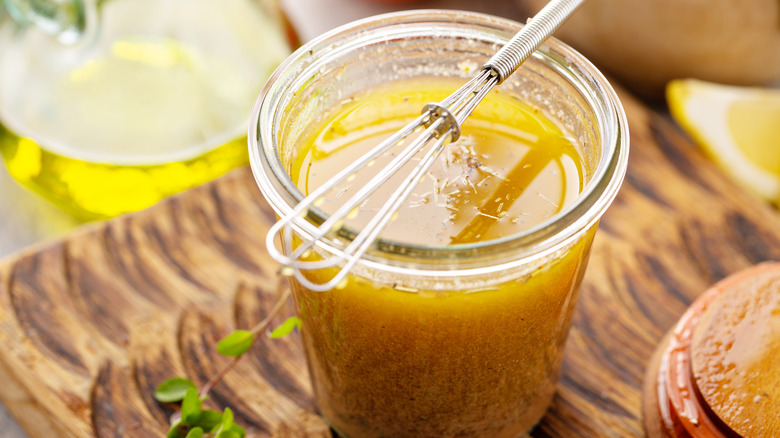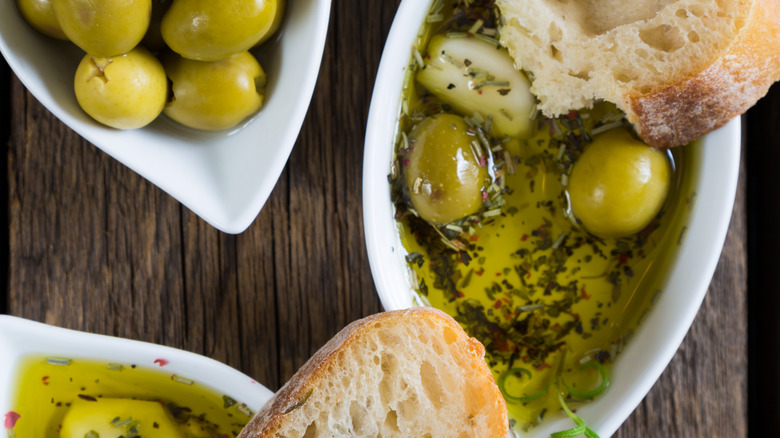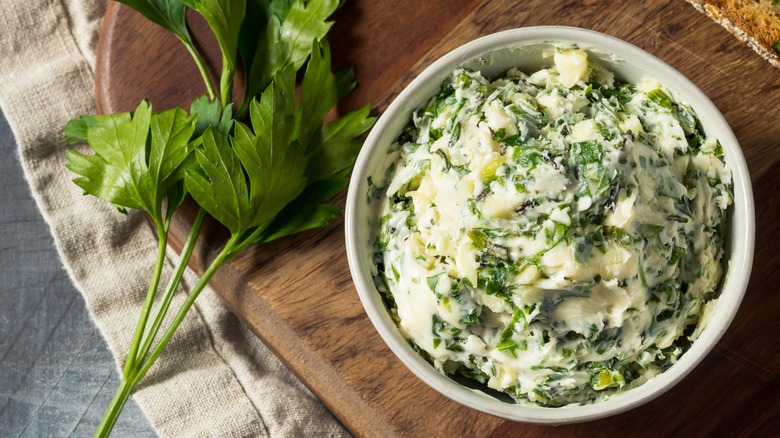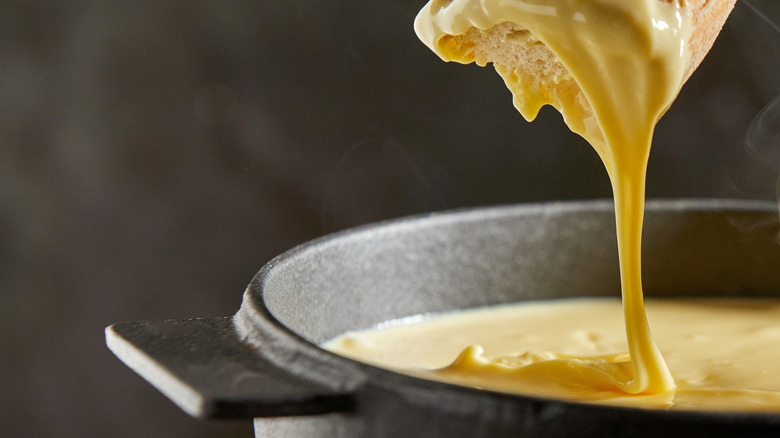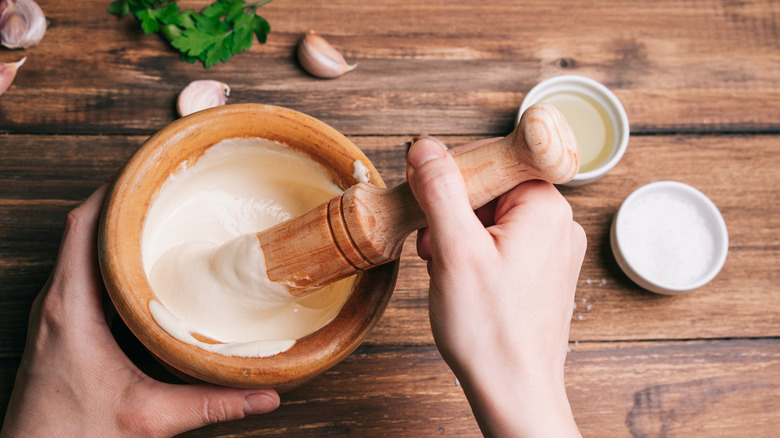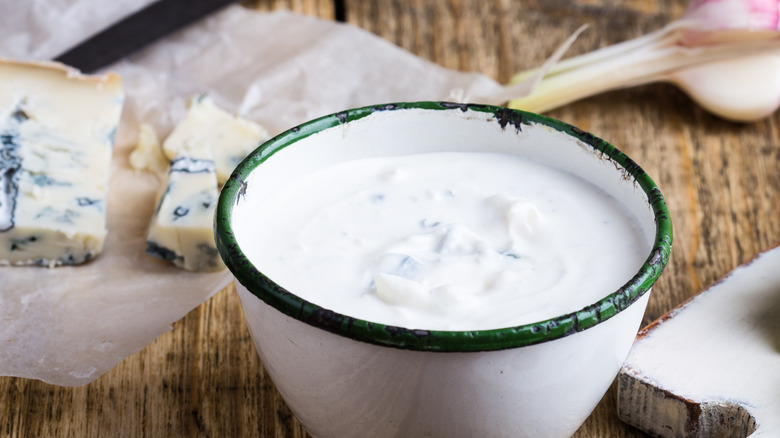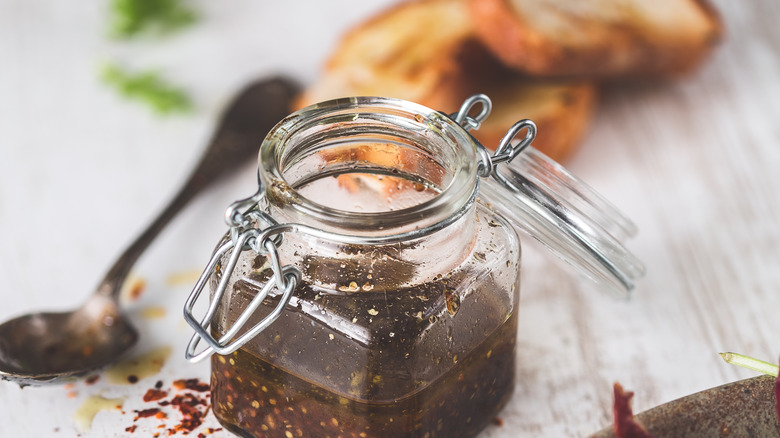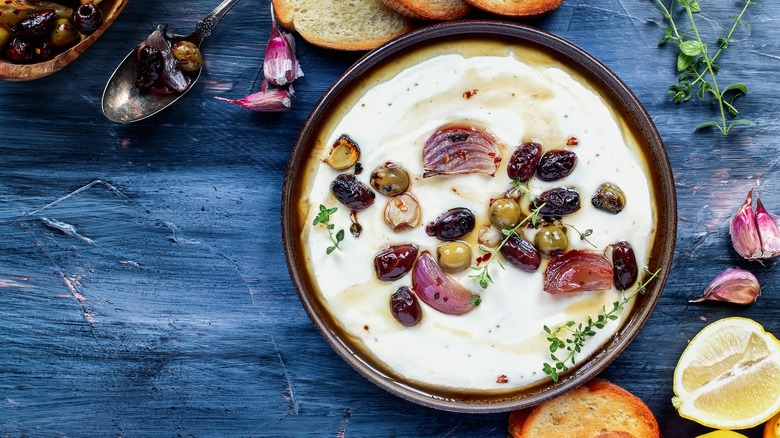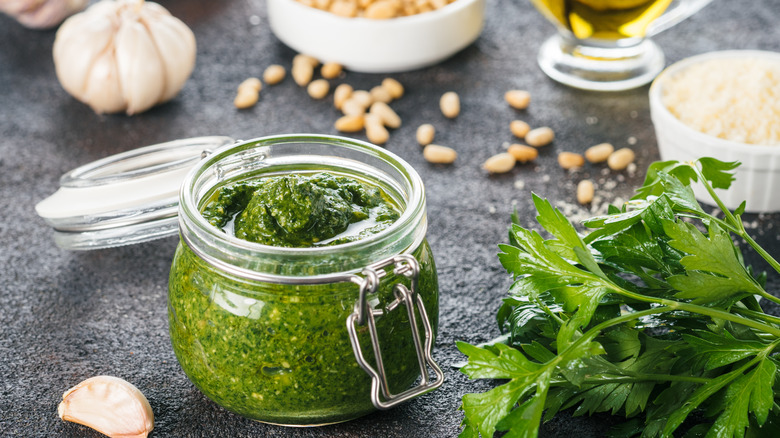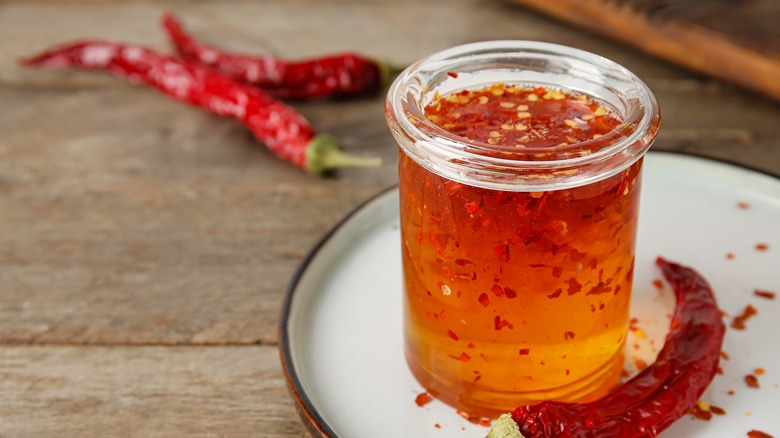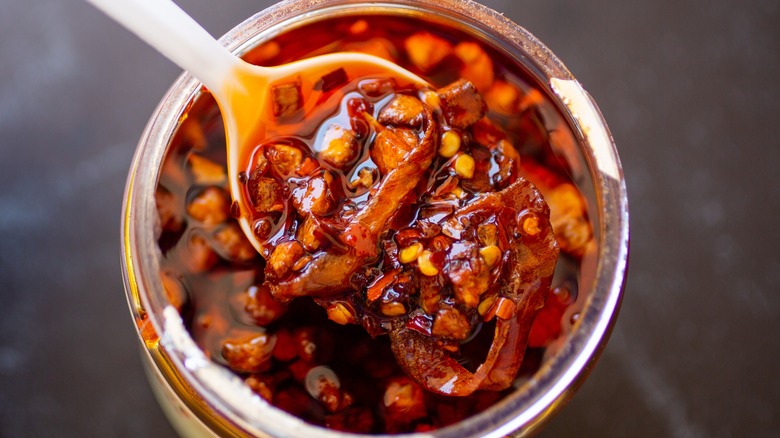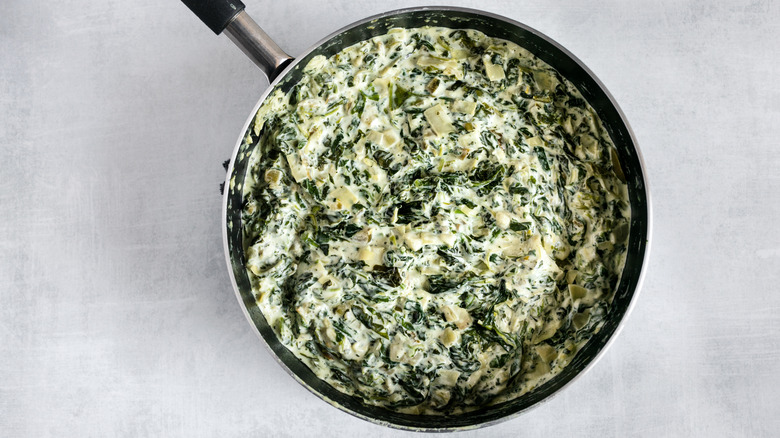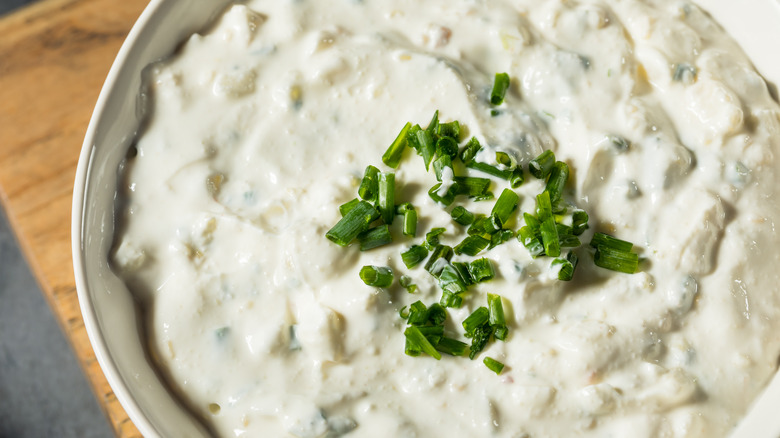18 Absolute Best Sauces For Dipping Your Pizza Crust
There's something so irresistible about pizza. The ooey-gooey bubbly brown cheese, the crispy crunch of the crust, the velvety sweet tomato sauce, the pungent herbs and spices. Whether you enjoy an artisanal thin crust with fresh balls of melted mozzarella or pineapple and ham with a stuffed crust from Pizza Hut Express, we can all agree that there's no better combination than cheese, bread, and sauce. But unless you love to eat plain crusts, eventually we're faced with the question of what to do with the bready exterior. It's more than just a handle for your to slice, so don't let it go to waste. Consider it a side dish, and use it to sop up your favorite sauce. Not all sauces were created equal, especially when it comes to pizza crust dipping, so we've gathered together the absolute best sauces for dipping your pizza crust.
From chunky, creamy dips to delicately flavored oils, there's no need to let those crusts go uneaten or leave them plain. Spice is the flavor of life, and it's time to indulge in some sauce. Get saucy at your next pizza party and put out a flight of dipping sauces for your guests. After all, who doesn't love a little extra flavor?
Barbecue sauce
We are no strangers to a light drizzling of barbecue sauce on a chicken and red onion pizza, but it often goes overlooked when it comes to crust dipping. Although this condiment might seem better fitted for a burger or rack of ribs, its tangy sweet flavor happens to complement cheese, bread, and tomato beautifully. Adding a light element of smokey sweetness to the mix can give your palette a change of pace from the salty and umami flavors of a standard cheese pizza.
Even if barbecue sauce isn't a topping of choice for your particular pie, that doesn't mean it won't go well with that extra edge of crust. Drizzle it on, or go ahead and dip it right into the bowl like a chicken tender. Either way, your taste buds will be going wild for the spices, sweetness, and tomatoey goodness of barbecue sauce.
Marinara sauce
Why stray from a classic? When it comes to dipping sauces, there's nothing better suited for the job than good old marinara. For those who are all about the sauce and love a thick layer of tomato sauce that seeps out the sides of your slice when you take a bite, then look no further for a dipping sauce extraordinaire. The best way to go is to use leftover sauce from your pasta dinner the other night or to spring for one of the best store-bought pasta sauces. Marinara sauce is often sweeter than pizza sauce because it's been cooked down for longer. It can also be chunkier, contain more liquid, and happens to be a bit tastier on its own. Do some damage to that leftover marinara, and use your pizza crusts to eliminate the evidence. Why fix what isn't broken?
Arrabiata
While marinara seems like an obvious pick, if you like to get spicy, you should consider dipping your pizza crusts in arrabbiata. For those of you who don't know what it is, or haven't accidentally brought it home thinking it was your standard red sauce, it is actually a spicy version of classic marinara sauce. This Italian sauce is made with red chiles and has quite a kick to it.
The added spice can be a nice change of pace when it comes to dipping your pizza crust, as the pizza itself is typically mild in spice — unless, of course, you are a fan of buffalo chicken pizza or spicy sauce. Arrabiata is not for the weak, so be sure to give it a taste before you go dunking your pizza crusts all the way in.
Alfredo
Italian sauces are always a good idea when it comes to pizza crust dunking since pizza itself is a classic Italian food. The rule of thumb is if the sauce pairs well with pasta then it probably pairs well with pizza. Consider dunking your leftover pizza pie crusts in none other than marinara's creamy rival sauce, Alfredo. The sauce is made from cheese, cream, flour, garlic, and other aromatics and herbs. It's no surprise, then, that it pairs as well with crust as peanut butter does with jelly.
Cheese and bread were made for each other, so a cream-based garlic sauce should get the job done. Be sure to warm up the Alfredo sauce before using your leftover pizza crusts to sop it all up. We can assure you this sauce and pizza crust pairing is a real game changer.
Ranch dressing
In America, we put mayonnaise in salads, potato chips on sandwiches, and ranch dressing on absolutely everything. College kids drink ranch straight from the bottle, and everyone in the Midwest seems to have a full container in their refrigerator. There isn't a dish that has gone un-ranched in some parts of the United States. Pizza is no exception, but let us tell you, it actually tastes pretty darn delicious.
Cool ranch on a buffalo chicken pizza helps to mellow some of the vinegar and heat. Even without the addition of spicy buffalo sauce to a pie, it still tastes incredible when drizzled lightly on a standard cheese pizza. It is both a dip and a dressing, so why not use it to enhance your leftover pizza crusts? Dunk it, drizzle it, or scoop it up. The cool creamy dressing will be sure to leave you wanting more. Don't have a bottle on hand? It's easy to whip up a homemade buttermilk ranch dressing recipe right in your kitchen.
Mediterranean dressing
If you know your way around the kitchen, then you're probably very aware that Italian dressing can do much more than just flavor lettuce. It can be used as a grilling marinade for chicken, steak, or tofu, it can be added to vegetable stir fry, or it can be used as a dip for sandwiches. Both Greek and Italian dressings have quite a range, and pizza is no exception.
Drizzle it on your cooked pie, or use it as a dipping sauce for the crusts. Mediterranean dressings are light, tangy, and herby in flavor, which breaks up the rich taste and mouthfeel of pizza. In the end, it's always safe to stick to sauces and dressings that come from the same geological region and culture that pizza does. Dip away!
Herbed olive oil
Much like dressings, herbed olive oil has been used to flavor bread for centuries. Some pizza restaurants even serve a shallow dish of herbed olive oil alongside bread rolls before your pizza even comes out of the oven. If you've never had the experience of enjoying such an oil, we're here to break it down for you.
Typically, herbed olive oil contains high-quality extra virgin olive oil, Parmesan cheese, sea salt, crushed black pepper, Italian herbs and spices, and crushed chili pepper. Fresh herbs like parsley, basil, and oregano work best. Sometimes, a little bottle of balsamic dressing will be served alongside the oil, with the intention that the diner will drizzle it into the dish before dipping. This stuff is essentially made for fresh bread, so it's no wonder that it tastes fantastic with the fresh crust of a pizza. If you make herbed olive oil at home, be sure to select the best fresh, high-quality olive oil you can find.
Garlic butter
Nobody is kidding themselves about making a healthy food choice when they order a pizza, and that's okay. Greasy melted cheese is unmatched but doesn't always leave a good feeling the next day. That said, if your body has no problem handling dairy, then it's time to load it up to the max. Turn your unwanted pizza crusts into garlic bread by dousing it with garlic butter.
Make your own three-ingredient garlic butter by mixing butter with roasted garlic and minced parsley. Heat it slightly to ensure that it is in liquid form, and brush it lightly on your pizza crust, or dunk the crust right into the melted vat of garlicky, buttery goodness. If you'd prefer to smear the butter on at room temperature as you would with a dinner roll, it should taste just as delicious.
Beer cheese or fondue
There's no better way to celebrate your devoured cheezy pizza than with more cheese. Melted cheese is as good as it gets, so why not keep the party going with your pizza crusts? Beer cheese and fondue are our favorite dippable hot cheese, so it's no wonder they made the list
Beer cheese, as you may have guessed, contains beer and cheese. But despite its straightforward name, beer cheese is more complex than you might expect. Typically, IPAs are selected for the mix, and often times additional ingredients like mustard, onions, and Worcestershire sauce are added for flavor. Fontana and sharp yellow cheddar are top picks for cheese varieties, but feel free to experiment with a blend of cheese you may have on hand.
Fondue, on the other hand, is a Swiss dish typically made with a variety of cheeses like Gruyere, kirsch, and Swiss cheese. White wine is added, along with garlic and other aromatics. Fondue is served over an open flame so it can remain ooey-gooey and dippable.
Aioli
Aioli might seem better suited as a sandwich spread, but it also makes an incredible dip for bread. It's not just flavored mayonnaise, either — in fact, it is actually made of entirely different ingredients. The thing you need to know about aioli is that it has a cleaner, lighter flavor laden with garlic and lemon. Although the two are rather uncanny and have a similar flavor profile, mayonnaise is made from an egg, mustard, and canola oil base, while aioli is traditionally made from olive oil, lemon juice, garlic, and salt. These days, most flavored mayonnaise passes as aioli, but we recommend using the real stuff when it comes to dunking pizza crusts.
Unlike mayonnaise, aioli was traditionally used as a dipping sauce for vegetables, fish, and bread, so pizza crust fits the bill. Its creamy richness is in step with pretty much any style or flavor of pizza.
Blue cheese dressing
Blue cheese is sometimes found on artisanal pizzas paired with ingredients like figs, bacon, and arugula. It's a moldy, creamy, crumbly cheese that is distinguished by the veins of blue mold that marble it. It has a sharp, intense flavor that people tend to either hate or love. Blue cheese dressing, on the other hand, has a creamier, milder, and less intense overall flavor. Instead of making its way onto fancy flatbreads, blue cheese dressing is often found paired with buffalo sauce on chicken-based pizzas.
Even if your pizza isn't artisanal or loaded with buffalo sauce, consider using blue cheese as a dipping sauce for any uneaten crusts. And if you don't happen to have a bottle on hand, it's relatively simple to make a basic blue cheese dressing recipe with ingredients commonly found in the fridge, although you may have to run to the market for blue cheese. Enjoy the sharp, creamy flavors of blue cheese dressing on your pizza crusts.
Balsamic vinaigrette
Balsamic vinaigrette is simply balsamic vinegar emulsified with olive oil, herbs, and aromatics. Sometimes ingredients like oregano, red pepper flakes, minced garlic, dijon mustard, and even honey or maple syrup are added to round out the dressing. While most vinaigrettes contain some form of vinegar, balsamic vinegar differs greatly from most other vinegar because it is rich, sweet, and has quite a different production process including long-term aging like wine. This gives balsamic vinaigrette a unique richness that goes unmatched. When blended into a vinaigrette it usually finds its way onto salads but makes for an incredible pizza crust dip. It's sweet and tangy because of the balsamic, but the mellow fattiness of the olive oil helps to balance the dressing.
Some people enjoy their bread dipped in an olive oil and balsamic mixture before dinner, so it's not a stretch to use a freshly baked pizza crust to absorb the tangy, fatty goodness of balsamic vinaigrette.
Whipped feta dip
It's time for your hot and bubbly mozzarella pizza to meet its grandfather, the original cheese. It's speculated that the first cheese ever made was feta, which is referred to first in Homer's "The Odyssey," per the British Museum. Greece led the charge, and the world soon followed with new varieties like cheddar, Gruyere, and mozzarella. Feta, however, remains the granddaddy of all cheese.
It can be argued that whipped feta tastes good on pretty much anything, savory or sweet. And let us tell you, pizza crust is no exception. While any pizza flavor makes a perfect match with the bitey cheese, Mediterranean flavors like fig, arugula, olive, and artichoke pair especially well. A simple whipped feta dip can be made with cream cheese, parsley, lemon juice, salt, pepper, and of course, feta cheese. With its nippy fresh flavor and creamy texture, you can never go wrong with pairing cheese and bread.
Pesto
There's nothing more irresistible than the tangy, nutty, and rich taste of fresh basil pesto. It is a favorite when it comes to pasta, which means of course, that it pairs just as well with pasta's crunchy fluffy counterpart, bread. Each ingredient of pesto would do beautifully on pizza on its own. Basil? Yup. Garlic? Sure. Pine nuts? You bet. Olive oil? Of course. Parmesan cheese? Duh.
Combine those heavenly ingredients to get the dipping sauce of a lifetime. It almost feels made to help jazz up those boring pizza crusts after the cheesy, saucy part is down the hatch. Pesto has long been a classic favorite but hasn't necessarily found its way onto the pizza scene, besides small appearances on a pie here and there. Why deprive ourselves any longer? Bring a jar of fresh pesto with you to your next pizza party and don't let those crusts go to waste.
Hot honey or honey butter
The famous sweet and savory combination has been infiltrating the food scene for some time now, and we are here for it. Chicken and waffles, maple bacon, and the classic Wendy's Frosty with fries are just the tips of the iceberg. There's a reason why sweet and salty foods taste good together. The contrast, when done right, is exciting to our tastebuds because we crave both food elements
While you may not want to drizzle sugar on your pizza or dip the crust into molasses, honey seems to have a different effect when paired with savory foods. The richness, along with the floral, earthy, and fruity flavor of honey seemed to make an instant bond with salty foods like butter. The pair have found their way into numerous dishes, and make for an incredible dip for pizza crusts. It's the perfect ending to a savory pie.
Hot honey, meanwhile, has an intense and spicy flavor to balance the sweetness and can be enjoyed drizzled on many artisanal pizzas featuring meats, fruits, greens, and unique cheeses, or used as a dip for the leftover crusts.
Chili oil
Some like it hot, and for those who do, hot sauce, pepper flakes, and chili oil are welcome guests at the table. While many opt to sprinkle chili flakes directly onto their pie, others prefer to indulge in aromatic chili oil, which includes chili flakes, garlic, oil, salt, and often additional peppers for heat and appearance. The mixture is more complex than your standard shake-on chili flakes and can be a fantastic way to flavor your pizza crusts.
For those with weaker heat tolerances, consider mixing in additional olive oil or Parmesan cheese to dampen the heat. For those who like to crank up the heat, enjoy your crusts soaked in spicy hot, garlicky oil that certainly leaves an impression. You don't want it to overpower your pie, so the timing is perfect to enjoy it at the end along with your crusts. Who doesn't enjoy adding a little spice to their life?
Spinach artichoke dip
Dips that typically call for crostini or freshly baked bread are usually a safe bet when it comes to selecting the absolute best sauces for dipping your pizza crust. Because, in the end, what is pizza crust other than a crunchy, crispy version of a bread roll hot out of the oven?
Spinach artichoke dip is one of those rare dips that is loaded with creamy, fatty cheeses but also chock full of green vegetables. It's the perfect combination of healthy and indulgent, and it deserves consideration when it comes to the world of pizza crust dips. When made correctly, spinach artichoke dip should be creamy, chunky, soft, and slightly tangy. Its ingredients vary, but your typical spinach and artichoke dip recipe often contains cream cheese, sour cream, cheeses like mozzarella or Parmesan, a form of acid like vinegar or lemon juice, garlic, and of course spinach and artichoke hearts. The tang plays off the pizza crust well, and we already know that bread and cheese are perfect together
French onion dip
Although French onion dip is typically accompanied by potato chips, it's a dip without boundaries. Enjoy it with fresh vegetables, crostini, French fries, and even pizza crusts. Typically, it is made from caramelized onions, garlic, sour cream, mayonnaise, butter, and salt. Although it's not necessarily heart-friendly, it certainly does pack a punch of flavor and is extremely decedent to boot. The sweet and bitey flavors of the onion, along with the creaminess of the sour cream and mayo, make for a delightfully balanced mouthfeel that will blow your friends and family away. But seriously, try to avoid the dip before a first date, job interview, or dentist appointment.
The buttery goodness of French onion dip can elevate your pizza crusts and give them new life after your finished slice. The rejected crusts deserve to be a dish of their own, but they need a sauce to bring them to the next level. French onion dip is plenty creamy and pungent enough to be that sauce, bringing that sweet carmelized onion flavor you didn't realize your pizza crust actually needed.

